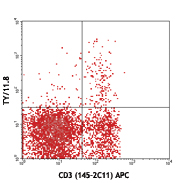- Clone
- G8.8 (See other available formats)
- Regulatory Status
- RUO
- Other Names
- CD326, EGP40, MIC18, TROP1, KSA
- Isotype
- Rat IgG2a, κ
- Ave. Rating
- Submit a Review
- Product Citations
- publications

-

TE-71 cell line stained with G8.8 purified, followed by anti-rat IgG PE
| Cat # | Size | Price | Save |
|---|---|---|---|
| 118201 | 50 µg | ¥12,640 | |
| 118202 | 500 µg | ¥50,200 |
EpCAM (CD326) mediates calcium-independent homophilic cell to cell adhesion. It may also function as a growth factor receptor. It is thought to be involved in maintaining cells in position during proliferation. Expression of EpCAM seems to correlate inversely with the level of E-cadherin (CD324). EpCAM is considered important in tumor biology.
Product DetailsProduct Details
- Reactivity
- Mouse
- Antibody Type
- Monoclonal
- Host Species
- Rat
- Immunogen
- TE-71 thymic epithelial cell line
- Formulation
- Phosphate-buffered solution, pH 7.2, containing 0.09% sodium azide.
- Preparation
- The antibody was purified by affinity chromatography.
- Concentration
- 0.5 mg/ml
- Storage & Handling
- The antibody solution should be stored undiluted between 2°C and 8°C.
- Application
-
FC - Quality tested
IHC-F, ICC - Reported in the literature, not verified in house - Recommended Usage
-
Each lot of this antibody is quality control tested by immunofluorescent staining with flow cytometric analysis. For flow cytometric staining, the suggested use of this reagent is ≤0.06 µg per million cells in 100 µl volume. It is recommended that the reagent be titrated for optimal performance for each application.
- Application Notes
-
Additional reported applications for clone G8.8 (for the relevant formats) include: immunohistochemistry of frozen sections: acetone fixed1, with or without OCT embedding2,4, and spatial biology (IBEX)13,14.
-
Application References
(PubMed link indicates BioLegend citation) -
- Farr A, et al. 1991. J. Histochem. Cytochem. 39:645. (FC, IHC)
- Dooley J, et al. 2005. J. Immunol. 175:4331. (FC, IHC)
- Hinterberger M, et. al. 2010. Nat. Immunol. 11:512. (FC) PubMed
- Gracz AD, et al. 2010. Am J. Physiol Gastrointest Liver Physiol. 298:590. (IHC) PubMed
- Nudel I, et al. 2011. J. Immunol. 186:891. PubMed
- Morimoto H, et al. 2012. Biol Reprod. 86:148. PubMed
- Ishii K, et al. 2012. Development. 139:1734. PubMed
- Takehashi M, et al. 2012. Biol Reprod. 86:178. PubMed
- Murakami R, et al. 2013. PLoS One. 8:73270. PubMed
- Taguchi K, et al. 2014. Mol Cell Biol. 34:900. PubMed
- Hirokawa Y, et al. 2014. Am J Physiol Gastrointerest Liver Physiol. 306:547. PubMed
- Ding X, et al. 2015. Cancer Res. 75:330. PubMed
- Radtke AJ, et al. 2020. Proc Natl Acad Sci U S A. 117:33455-65. (SB) PubMed
- Radtke AJ, et al. 2022. Nat Protoc. 17:378-401. (SB) PubMed
- Product Citations
- RRID
-
AB_1089026 (BioLegend Cat. No. 118201)
AB_1089027 (BioLegend Cat. No. 118202)
Antigen Details
- Structure
- 40 kD single-pass type 1 glycoprotein. 293 amino acids, with a 21 aa signal peptide, a 246 aa extracellular domain, a 21 aa transmembrane domain, and a 26 aa cytoplasmic domain. The extracellular domain contains two epidermal growth factor-like repeats.
- Distribution
-
Expressed on majority of epithelial cell membranes with the exception of adult squamous cells of the skin and a few specific epithelial cell types.
- Function
- Mediates calcium-independent homophilic cell-cell adhesion.
- Interaction
- CD326 displays hemophilic binding.
- Ligand/Receptor
- CD305 (LAIR-1), CD306 (LAIR-2), and Ep-CAM.
- Cell Type
- Embryonic Stem Cells, Epithelial cells
- Biology Area
- Immunology, Stem Cells
- Molecular Family
- Adhesion Molecules, CD Molecules
- Antigen References
-
1. Borkowski TA, et al. 1996. Eur. J. Immunol. 26:110.
2. Bergsagel PL, et al. 1992. J. Immunol. 148:590. - Gene ID
- 17075 View all products for this Gene ID
- UniProt
- View information about CD326 on UniProt.org
Related Pages & Pathways
Pages
Customers Also Purchased



Compare Data Across All Formats
This data display is provided for general comparisons between formats.
Your actual data may vary due to variations in samples, target cells, instruments and their settings, staining conditions, and other factors.
If you need assistance with selecting the best format contact our expert technical support team.









Follow Us